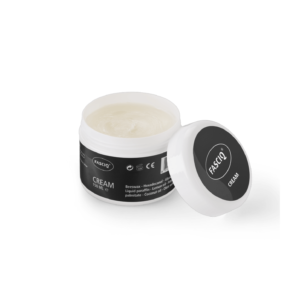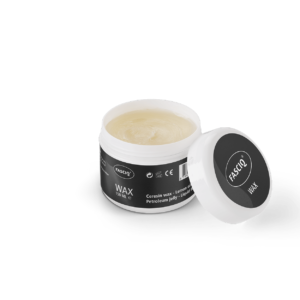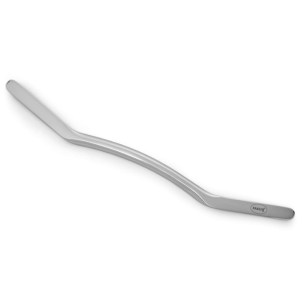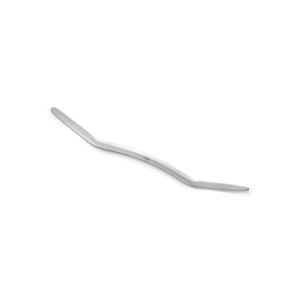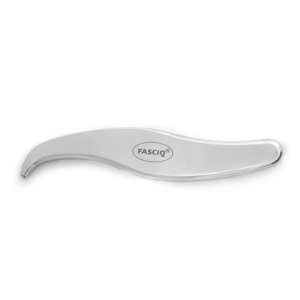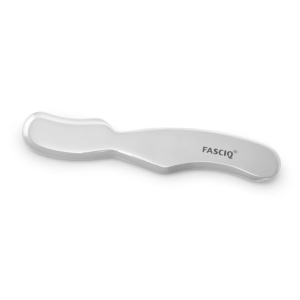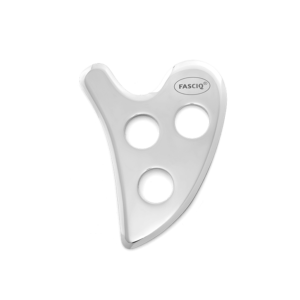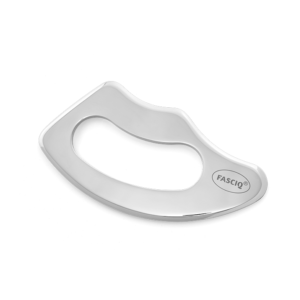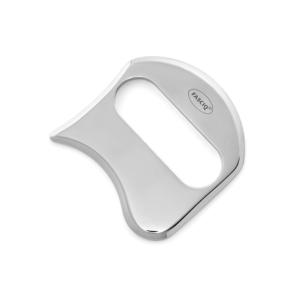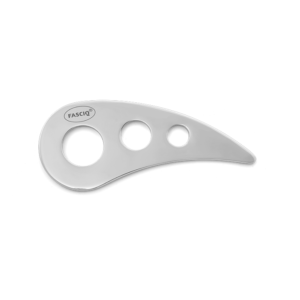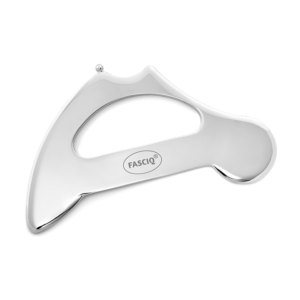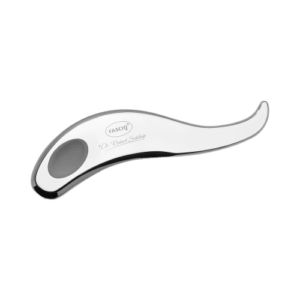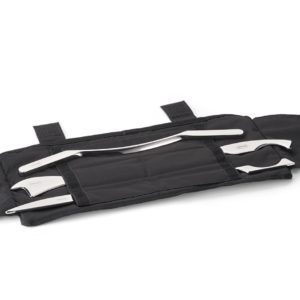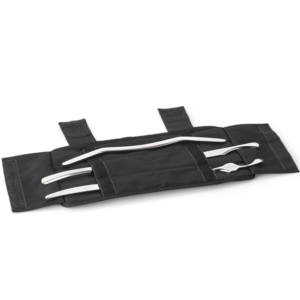IASTM tools
The
FASCIQ® IASTM Tools ("Instrument-Assisted Soft Tissue Mobilization Tools" or in short "Instrument Assisted Massage Tools") consist of a number of separate tools that look different with various finished sides. In addition to separate instruments, FASCIQ
® also offers two complete IASTM toolsets with various shaped tools. All
IASTM Tools are packed in a sturdy, beautiful storage bag. Usually, each tool has multiple shapes and finished edges to increase its employability. The smaller tools are generally used for the treatment of smaller parts of the body, smaller strokes and reaching superficial tissue structures. The larger and heavier tools are used to reach deeper and are suitable for the treatment of larger parts of the body. These
IASTM tools help prevent joint wear and strains complaints among therapists.
Various shaped instrument assisted massage tools
- Concave shape, this is a rounder, long curve.
- Convex shape, this is a tube-shaped indentation.
- Round blunt shape (for more pressure and deeper layers).
- Hook shape (among other things for the treatment of trigger points).
How to use FASCIQ® Scraping Tools
FASCIQ® - Recommended by Dr. Robert Schleip
“We are delighted to include FASCIQ® as one of our partners. Not only do we share a common purpose – supporting medical health professionals achieve their aspirations – we know how fundamental education and a well applied fascia treatment concept, which is based on well conducted scientific research, can improve clients’ well beings on a global level.”
- Dr. Robert Schleip
Fascia Research Group, Munich, Germany
★★★★★
"Excellent product. FASCIQ IASTM tools are a welcomed addition!"
- Luke Rudkin
Sports Physiotherapist at Premiership side Gloucester Rugby
★★★★★
"First time purchasing from this website. I bought an iastm tool that i really like to use and an upgrade from the previous tool I was using. Shipping was pretty fast. Overall, very happy with everything. Will buy again in the future!"
- Tony
★★★★★
“Service and delivery was so fast. My IASTM tools are fantastic, great quality. Very satisfied”
- Zoë
★★★★★
“I ordered an IASTM tool from Thysol.
The tool was excellent quality and shipped quickly. I will use Thysol again!”
- Ryan
What is IASTM therapy?
Many people are talking about this new treatment, but what is IASTM therapy? IASTM stands for instrument assisted soft tissue mobilization, this is a treatment for myofascial restriction.
How does IASTM therapy work?
Several therapists are using the IASTM technique, but how does it work? The IASTM tools can be used on several parts of the body. The tools are used as follows: the therapist applies pressure to the tool and glides across the skin to reach the soft tissue.
The IASTM tools are producing microtrauma to the affected tissue. This microtrauma will stimulate a local inflammatory process. As a result, it initiates reabsorption of unhealthy tissue and promotes tissue remodeling and healthy tissue production.
IASTM stands for "instrument-assisted soft tissue mobilization". It is a manual technique used to treat inflammation and discomfort, with the goal of reducing pain and restoring movement by affecting muscle tone and collagen synthesis.
Our IASTM tools are crafted from surgical-grade stainless steel, allowing for precise detection of specific areas of stress and adhesions. Unlike other tools on the market, our stainless steel IASTM tool is designed to detect individual adhesions and tensions with unparalleled accuracy. Its resonance and ergonomic design ensure a comfortable grip and maximum effectiveness. We are confident in the quality of our products and offer a 30-day return policy for customer satisfaction. Additionally, all of our IASTM tools come with a lifetime guarantee, further demonstrating our commitment to providing exceptional tools for soft tissue therapy.
What are the benefits of soft tissue mobilization?
First, we have the benefits of IASTM therapy for the physiotherapists. Many therapists use their fingers to apply pressure to the tissue. As a result, many therapists are struggling with common problems like wear and overload. With IASTM therapy these problems can be prevented.
Besides the benefits for physiotherapists there are also several benefits for the clients.
- The therapy can reduce the overall time of treatment
- It allows a faster recovery of rehabilitation
- It reduces the need for anti-inflammatory medication
- It can resolve chronic conditions
- Clients can continue to engage in everyday activities
What conditions would benefit from IASTM therapy?
There are several conditions which would benefit from this soft tissue massage. Some examples of conditions are shown in the list below:
- Cervical sprain/strain
- Lumbar sprain/strain
- Carpal Tunnel Syndrome
- Plantar Fasciitis
- Lateral Epicondylitis
- Medial Epicondylitis
- Rotator Cuff Tendinitis
- Patellofemoral Disorders
- Achilles Tendinitis
- Scar Tissue
- Trigger Finger
- Shin Splints
What IASTM toolsets are there?
IASTM tools also known as
graston tools,
muscle scraping tools,
fascia massage tools, fascia release tools, myofascial release tools or deep tissue massage tool come in different sizes and shapes. Depending on the area that needs to be treated and the trigger point the client indicates, the best instrument is chosen. The smaller tools are normally used for treatments of the smaller parts of the body and reaching superficial tissue structures. The larger and heavier tools are used for the treatment of the larger parts of the body and are used to reach deeper.
Which IASTM tool to choose?
The FASCIQ® IASTM Tools ("Instrument-Assisted Soft Tissue Mobilization Tools" or in short "Instrument Assisted Massage Tools") consist of a number of separate tools that look different with various finished sides. In addition to separate instruments, FASCIQ
® also offers two complete IASTM toolsets with various shaped tools. All IASTM Tools are packed in a sturdy, beautiful storage bag. Usually, each tool has multiple shapes and finished edges to increase its employability. The smaller tools are generally used for the treatment of smaller parts of the body, smaller strokes and reaching superficial tissue structures. The larger and heavier tools are used to reach deeper and are suitable for the treatment of larger parts of the body. These IASTM tools help prevent joint wear and strains complaints among therapists.
This is one of our bestsellers! A robust IASTM tool with a straight finish at the bottom and an inward-faced flat edge at the top. Ideal for scanning tissue. This tool has different shapes, such as a concave side, a convex side and jagged corners. This makes it widely applicable.
Our newest addition to the family! We specially developed it in cooperation with Dr. Robert Schleip, director of the fascia institute in Munich, Germany. He knows what he is talking about! Our tool reflects that.
Another tool that is great for general use. The mustache is wide applicable and light to hold.It has a flat finish on the bottom. The top has both round and upwardly slanted edges. There is also a pointed side of the tool that allows you to reach deeper fascial layers.
Using an IASTM tool is very personal and depends on the type of massage you have and the parts of the body to be massaged. Therefore, look especially for a tool that should be an extension of your hand. There is one for everyone! Can't choose? We have two handy tool sets that contain several of our tools. Handy to take with you on the road! Because the tools are made of high-quality surgical steel, they will quickly adapt to your body temperature. So the massage is not only pleasant for the massaged, but also for you as a masseur.
Where to buy IASTM tools in Australia?
The IASTM tools can be bought at
THYSOL Australia. As part of the
fascia massage tools range, we offer a wide variety of
FASCIQ®
IASTM tools. We offer different sizes and shapes and we offer a lifetime guarantee. You can also choose a
fascia wax which works well with the IASTM tools.

 IASTM tools are a perfect fit when you provide a lot of soft tissue massage and are looking for a tool to spare your hands. Each tool is ergonomically designed to provide maximum comfort and grip during use, reducing the risk of hand fatigue or injury. Check out our 5 tips for choosing the right tool
IASTM tools are a perfect fit when you provide a lot of soft tissue massage and are looking for a tool to spare your hands. Each tool is ergonomically designed to provide maximum comfort and grip during use, reducing the risk of hand fatigue or injury. Check out our 5 tips for choosing the right tool 